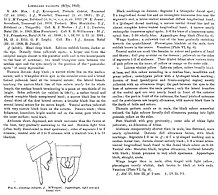Platycypha caligata
| Platycypha caligata | |
|---|---|

| |
| Male | |
| teneral male | |
| Scientific classification | |
| Kingdom: | Animalia |
| Phylum: | Arthropoda |
| Class: | Insecta |
| Order: | Odonata |
| Suborder: | Zygoptera |
| Family: | Chlorocyphidae |
| Genus: | Platycypha |
| Species: | P. caligata
|
| Binomial name | |
| Platycypha caligata (Selys, 1853)
| |
| Synonyms | |
|
Libellago caligata Selys, 1853 | |
Platycypha caligata, the dancing jewel, is a species of damselfly in the family Chlorocyphidae. It is found in eastern, central and southern Africa from Ethiopia to Angola and South Africa. Its natural habitats include shady parts of subtropical or tropical streams and rivers in forest, woodland, savanna, and shrubland, and shorelines of lakes.[1]

female, Ithala Game Reserve
Males perform remarkable territorial and courtship displays which include flashing their brightly coloured legs with flattened tibiae and waving their abdomens.[3][4][5]
References[]
- ^ a b Clausnitzer, V.; Suhling, F.; Dijkstra, K.-D.B. (2016). "Platycypha caligata". IUCN Red List of Threatened Species. 2016: e.T60005A75241796. doi:10.2305/IUCN.UK.2016-3.RLTS.T60005A75241796.en. Retrieved 11 November 2021.
- ^ Ris, Friedrich (1921). "The Odonata or Dragonflies of South Africa" (PDF). Annals of the South African Museum. XVIII: 245–452. Retrieved 13 November 2017.
- ^ Preston-Mafham, Rod; Preston-Mafham, Ken (1993). The encyclopedia of land invertebrate behaviour (1st MIT Press ed.). Cambridge, Mass.: MIT Press. p. 39. ISBN 0262161370. Retrieved 1 November 2014.
Platycypha caligata mating.
- ^ Jennions, M. D. (1998). "Tibial coloration, fluctuating asymmetry and female choice behaviour in the damselfly Platycypha caligata". Animal Behaviour. 55 (6): 1517–1528. doi:10.1006/anbe.1997.0656. PMID 9641997. S2CID 34960347.
- ^ Telford, S.; Barnett, M.; Polakow, Daniel (2005). "The functional significance of tibial displays in the damselfly Platycypha caligata (Selys) (Odonata: Chlorocyphidae)". Journal of Insect Behavior. 9: 835–839.
External links[]
 Media related to Platycypha caligata at Wikimedia Commons
Media related to Platycypha caligata at Wikimedia Commons Data related to Platycypha caligata at Wikispecies
Data related to Platycypha caligata at Wikispecies- Platycypha caligata on African Dragonflies and Damselflies Online
Categories:
- IUCN Red List least concern species
- Odonata of Africa
- Chlorocyphidae
- Insects described in 1853
- Calopterygoidea stubs



